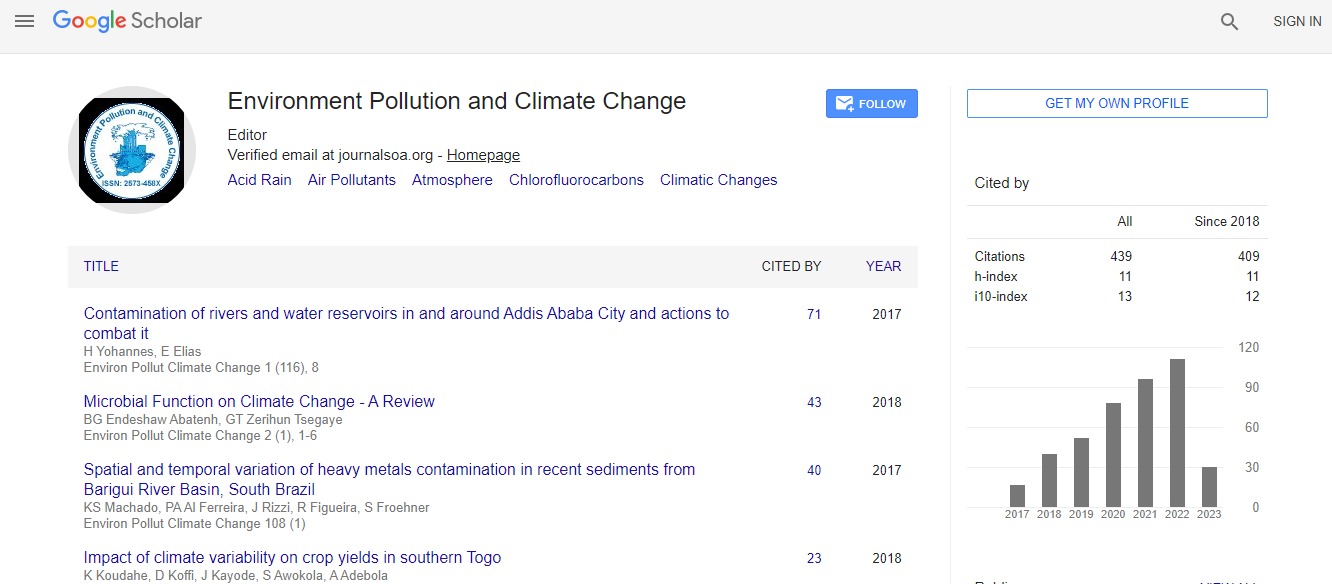Our Group organises 3000+ Global Conferenceseries Events every year across USA, Europe & Asia with support from 1000 more scientific Societies and Publishes 700+ Open Access Journals which contains over 50000 eminent personalities, reputed scientists as editorial board members.
Open Access Journals gaining more Readers and Citations
700 Journals and 15,000,000 Readers Each Journal is getting 25,000+ Readers
Google Scholar citation report
Citations : 672
Environment Pollution and Climate Change received 672 citations as per Google Scholar report
Environment Pollution and Climate Change peer review process verified at publons
Indexed In
- Google Scholar
- Publons
- Euro Pub
- ICMJE
Useful Links
Recommended Journals
Share This Page
Optical remote sensing for glacier monitoring: case studies in Chile
Global Summit on Environmental Health
Guido Staub
University of Concpeci√?¬≥n, Chile
ScientificTracks Abstracts: Environ Pollut Climate Change
Abstract
Glaciers, in the current context of a latent climate emergency, are a sensitive element that unequivocally expresses the effects of climate change. In Chile, glaciers are widely distributed in the Andes Mountains throughout the whole country. Chile concentrates the largest glacier surface area in South America (80.5% of the total surface covered by glaciers in South America). From north to south, glaciers in Chile vary morphologically as a result of the rugged national geography and its number and extent increase in the southernmost regions. In this contribution, we present with the help of case studies carried out in Chile during the last years, how optical remote sensing techniques can provide a powerful tool to survey remote glacier areas, where conventional surveying techniques are difficult to be applied. Different classification approaches were tested for their eligibility to identify these snow and ice types in the Tyndall glacier area in the Southern Patagonian icefield. As no labeled data was available for the investigated remote area, a novel method was tested to obtain labeled Sentinel-2 compliant data from theoretical spectral reflectance curves. The achieved classification results show that all examined classification approaches are suitable for detecting different spectral snow and ice classes on the glacier surface. Furthermore, it is necessary to estimate the relationship between the changes in glacier surface and volume and variations of climate parameters such as temperature and precipitation. The variations in volume and extend of five glaciers in the central Andes and three in the Southern Patagonian Ice Field were determined and put in the context of regional climate change and variability. Based on remote sensing observations and subsequent image processing, the results indicate that all glaciers show significant retreat in area and loss in volume. Furthermore, statistical analysis shows a close relationship between glacier retreat and climate variations.Biography
Guido Staub is with the Department for Geodetic Sciences and Geomatics Education of the University of Concepción in Chile. He holds a doctorate degree in Engineering from the Institute for Photogrammetry and Remote Sensing at the University of Karlsruhe, Germany His research and professional experience are related to lectures and scientific investigation in the broad field of Photogrammetry, Remote Sensing and digital image processing for environmental and climate change studies.

 Spanish
Spanish  Chinese
Chinese  Russian
Russian  German
German  French
French  Japanese
Japanese  Portuguese
Portuguese  Hindi
Hindi 
